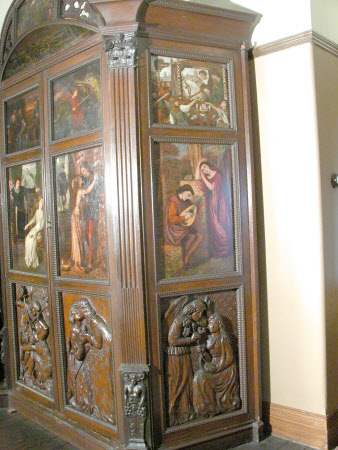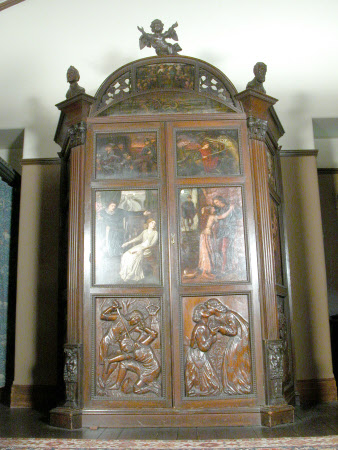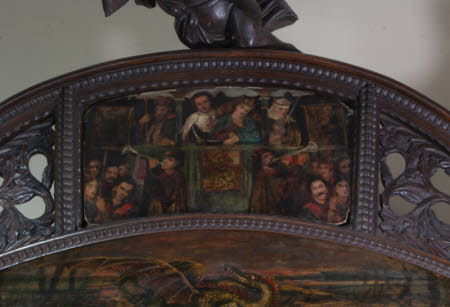The Theodore Watts-Dunton Cabinet
Henry Treffry Dunn (Truro 1838 - 1899)
Category
Furniture
Date
circa 1896 - circa 1898
Materials
Carved oak, oil paint
Place of origin
England
Order this imageCollection
Wightwick Manor, West Midlands
NT 1288304
Summary
A carved oak cabinet inset with ten variously shaped painted panels, British, circa 1896-1898, the carving possibly by Thomas Keynes, the painted panels by Henry Treffrey Dunn (1838-1899) after Rossetti, the domed and pierced pediment surmounted by a carved cherub with outstretched arms and raised wings, the pediment inset with a shaped painted panel above a second slender panel with curved top edge, the front of the cabinet inset with four figural painted panels in the upper section, the lower section with two relief carved panels, all set within moulded frames forming the two cupboard doors, the canted front corners with square-section reeded and fluted columns with decoratively carved sections to the bases, a corinthian capital to each column, each capital mounted with a splayed pedestal supporting a carved bust, one of Michael-Angelo and the other of Dante, the sides of the cabinet of similar form to the front, each with an upper section inset with two figural painted panels, the lowers section with a relief carved panel all within moulded frames, on shaped base.
Full description
A carved oak cabinet inset with ten variously shaped painted panels, British, circa 1896-1898, the carving possibly by Thomas Keynes, the painted panels by Henry Treffrey Dunn (1838-1899) after Rossetti, the domed and pierced pediment surmounted by a carved cherub with outstretched arms and raised wings, the pediment inset with a shaped painted panel above a second slender panel with curved top edge, the front of the cabinet inset with four figural painted panels in the upper section, the lower section with two relief carved panels, all set within moulded frames forming the two cupboard doors, the canted front corners with square-section reeded and fluted columns with decoratively carved sections to the bases, a corinthian capital to each column, each capital mounted with a splayed pedestal supporting a carved bust, one of Michael-Angelo and the other of Dante, the sides of the cabinet of similar form to the front, each with an upper section inset with two figural painted panels, the lowers section with relief carved panel all within moulded frames making on the side, on shaped base. The painted panels to the upper section of the cabinet depict scenes from the legend of Saint George and the Dragon, these include 1288304.2 (left side, top) - The skulls brought to the king; 1288304.3 (front, top left) - The princess Sabra taken to the Dragon; 1288304.4 (front, upper right) - Saint George and the Dragon; 1288304.5 (right side, top) - The return of the princess; 1288304.10 (upper pediment, shaped panel) - The wedding of Saint George; 1288304.11 (lower pediment, shaped panel) - The Dragon. The painted panels to the middle section of the cabinet depict various scenes after works by Rossetti, these include 1288304.6 (left side, middle) - How they met themselves; 1288304.8 (front, middle left) - Hamlet and Ophelia; 1288304.7 (front, middle right) - Faust and Margaret in Prison; 1288304.9 (right side, middle) - Genevieve. The carved oak panels to the lower section of the cabinet depict various scenes after works by Rossetti, these include 1288304.12 (left side, bottom) - Astarte Syriaca; 1288304.13 (front, bottom left) - The death of Breuze sans pitie; 1288304.14 (front, bottom right) - The Rose Garden; 1288304.15 (right side, bottom) - The Annunciation. Theodore Watts-Dunton (1832-1914) was born in St.Ives. He studied and practiced law but his real passion was literature, he was a published novelist, poet and reviewer and was a known figure in the literary world at the turn of the century. A friend to the pre-raphaelites, he looked after many of their business affairs and for 30 years he cared for the poet Algernon Charles Swinburne following his collapse in 1879, taking him to live with him at 'The Pines' in Putney. Henry Treffrey Dunn (1838-1899) was born in Truro. His father, a tea and spice merchant, found him a job in a bank, but Dunn eventually abandoned this and moved to London to study at Heatherley's art school. In 1867 he became Rossetti's studio assistant, gradually becoming his unofficial secretary, manager of his household and companion between then and 1881. His duties included painting and drawing to assist the production of finished pictures and making replicas, obtaining materials, props, models etc. Rossetti wrote "You are the best of fellows and my guardian angel." After Rossetti's death in 1882 Dunn completed some unfinished Rossetti works and helped William Michael Rossetti clear the house. He tried unsuccessfully to pursue a career as an independent artist, renting his own studio and exhibiting. He began drinking heavily, damaging his health. By 1892 he was reduced to painting furniture in a second-hand shop in the Kings Road. In the mid 1890s, penniless and ill, he sought help from Rossetti's friend Theodore Watts-Dunton at 2 The Pines, Putney. Watts-Dunton, who had already given a home to the poet Swinburne, provided Dunn with a studio and materials at The Pines and lodgings nearby. He spent the remainder of his life painting, often subjects suggested by Watts-Dunton. (adapted from author's unpublished property catalogue, Stephen Ponder, Wightwick Manor, circa 1995) Thomas Keynes
Provenance
Theodore Watts-Dunton, Bequeathed to Clara, wife of Theodore Watts-Dunton, then sold Sotheby & Co., New Bond Street, London, Wednesday, 22nd March 1939, lot 80, 'Catalogue of Artistic & Literary Property connected with Rossetti, Swinurne Ford Maddox Brown, etc. removed from "The Pines", 11 Putney Hill (The home of A.C.Swinburne and Walter Theodore Watts-Dunton) / Sold by order of the trustees of the will of Walter Theodore Watts-Dunton (decd.) / Consequent on the death of Clara, Mrs. Watts-Dunton...', p.21 - 'A CARVED OAK CABINET, framing eight panels painted by Treffry Dunn after Rossetti. The cabinet is of classical design, the cornice surmounted by two carved busts - Michael-Angelo and Dante. The panels are ranged in two series, the upper with four incidents from the story of St. George and the Dragon, the lower with "How they met themselves", Hamlet and Ophelia, Faust and Margaret and an unidentified subject of Lovers, 8ft. 8in. high, 6ft 6in. wide' Purchased at Sotheby & Co. sale by Geoffrey Mander Presented to the National Trust by Geoffrey Mander, 31st July 1939 In 1937 Sir Geoffrey Mander and his wife Rosalie gifted Wightwick Manor, its contents and gardens to the National Trust. Sir Geoffrey and his family continued to occupy and manage Wightwick adding to the collection in collaboration with the National Trust. Sir Geoffrey died in 1962 but Lady Mander continued to live at Wightwick until her death in 1988. The details of this cabinet were added to the Wightwick Manor 1937 inventory list in 1939.
Makers and roles
Henry Treffry Dunn (Truro 1838 - 1899), artist possibly Thomas Keynes, wood carver



